
Alberta is one of the thirteen provinces and territories of Canada. It is part of Western Canada and is one of the three prairie provinces. Alberta is bordered by British Columbia to the west, Saskatchewan to the east, the Northwest Territories (NWT) to the north, and the U.S. state of Montana to the south. It is one of the only two landlocked provinces in Canada. The eastern part of the province is occupied by the Great Plains, while the western part borders the Rocky Mountains. The province has a predominantly continental climate but experiences quick temperature changes due to air aridity. Seasonal temperature swings are less pronounced in western Alberta due to occasional chinook winds.

The economy of Alberta is the sum of all economic activity in Alberta, Canada's fourth largest province by population. Alberta's GDP in 2018 was CDN$338.2 billion.

The tertiary sector of the economy, generally known as the service sector, is the third of the three economic sectors of the three-sector theory,. The others are the secondary sector, and the primary sector.

Lethbridge is a city in the province of Alberta, Canada. With a population of 101,482 in its 2019 municipal census, Lethbridge became the fourth Alberta city to surpass 100,000 people. The nearby Canadian Rocky Mountains contribute to the city's warm summers, mild winters, and windy climate. Lethbridge lies southeast of Calgary on the Oldman River.

The economy of England is the largest economy of the four countries of the United Kingdom. England's economy is one of the largest and most dynamic in the world, with an average GDP per capita of £28,100. Her Majesty's Treasury, led by the Chancellor of the Exchequer, is responsible for developing and executing the government's public finance policy and economic policy. Government involvement is also primarily exercised by the Department for Business, Energy and Industrial Strategy. Regarded as a mixed market economy, it has adopted many free market principles, yet maintains an advanced social welfare infrastructure.
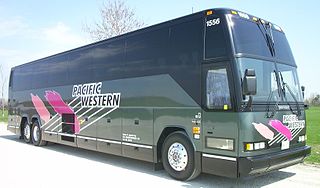
Pacific Western Transportation provides a variety of bus services in the Canadian provinces of British Columbia, Alberta, Saskatchewan, Ontario and Yukon. Depending on the location, it offers scheduled and chartered school busing, municipal transit and handi-bus services, airport passenger services and local and long distance coach charters.
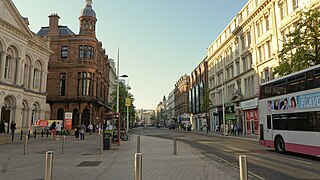
The economy of Northern Ireland is the smallest of the four constituents of the United Kingdom. Northern Ireland previously had a traditionally industrial economy, most notably in shipbuilding, rope manufacture and textiles, but most heavy industry has since been replaced by services.

The economy of Scotland had an estimated nominal gross domestic product (GDP) of $205 billion in 2020 including oil and gas extraction in Scottish waters. Since the Acts of Union 1707, Scotland's economy has been closely aligned with the economy of the rest of the United Kingdom (UK), and England has historically been its main trading partner. Scotland still conducts the majority of its trade within the UK: in 2017, Scotland's exports totalled £81.4 billion, of which £48.9 billion (60%) was with constituent nations of the UK, £14.9 billion with the rest of the European Union (EU), and £17.6 billion with other parts of the world.

Bow Valley College is a public, board-governed college operating as a comprehensive community institution under the Post-Secondary Learning Act of Alberta. The branch campuses are: Airdrie, Banff, Canmore, Cochrane, High River, Okoktoks, and Strathmore. Bow Valley College is a member of the Alberta Rural Development Network and Colleges and Institutes Canada.
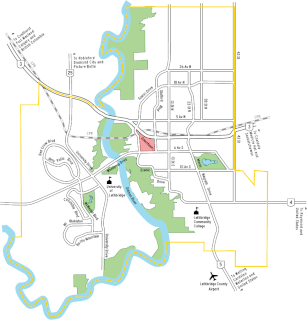
Chinook Regional Hospital is the main hospital for the City of Lethbridge and Southern Alberta, and offers many of the health care services for Alberta Health Services. The hospital services a population of over 150,000 and is supported by the Chinook Regional Hospital Foundation.

The modern history of Lethbridge extends to the mid-19th century, when the area was developed from drift mines opened by Nicholas Sheran in 1874, and the North Western Coal and Navigation Company in 1882. Prior to the development of drift mines in the area, Lethbridge, Alberta was known as Coal Banks, and was part of the territory of the Blackfoot Confederacy. The Confederacy was made up of the Kainai Nation, the Northern Peigan, the Southern Peigan (Blackfeet), and the Siksika Nation.
There are many forms of transport in Lethbridge, Alberta, Canada, including highways and public transit. Lethbridge's airport is Lethbridge Airport (YQL), which is south of the city boundary. Lethbridge also has an intricate cycling-and-pedestrian pathway that meets several destinations in the city, including the urban park system in the Oldman River valley.
Reeves College is a private for-profit post-secondary facility with five campuses in Alberta, Canada. The college specializes in training students for business, art and design, legal and health care related careers in under two years. Programs are developed in direct consultation with the business and health care communities to satisfy industry demands for certain skill sets. The college continuously accepts applications for enrollment in the next session of each certified career program.
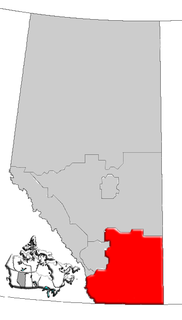
Southern Alberta is a region located in the Canadian province of Alberta. In 2004, the region's population was approximately 272,017. The primary cities are Lethbridge and Medicine Hat. The region is known mostly for agricultural production, but other sectors, such as alternative energy, film production and tourism, are emerging.
The City and County of Swansea is an urban centre with a largely rural hinterland in Gower; the city has been described as the regional centre for South West Wales. Swansea's Travel to Work Area, not coterminous with the local authority, also contained the Swansea Valley in 1991; the new 2001-based version merges the Swansea, Neath & Port Talbot, and Llanelli areas into a new Swansea Bay Travel to Work Area. Formerly an industrial centre, most employment in the city is now in the service sector.
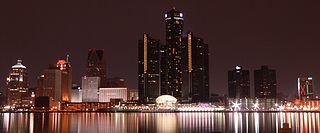
The metropolitan area surrounding and including Detroit, Michigan, is a ten-county area with a population of over 5.9 million, a workforce of 2.6 million, and about 347,000 businesses. Detroit's six-county Metropolitan Statistical Area has a population of about 4.3 million, a workforce of about 2.1 million, and a gross metropolitan product of $200.9 billion. Detroit's urban area has a population of 3.9 million. A 2005 PricewaterhouseCoopers study estimated that Detroit's urban area had a gross domestic product of $203 billion.

Calgary is a city in the western Canadian province of Alberta. With a population of 1,239,220, Calgary is the most-populous city in Alberta, the third most populous city in Canada after Toronto and Montreal, and the most populous city in Western Canada. The Calgary Metropolitan Area had a population of roughly 1,581,000 in the beginning of 2021, making it the second most-populous in western Canada, and the fourth-largest census metropolitan area (CMA) in Canada.

The Canadian Council on Africa (CCAfrica) was created on May 27, 2002 and is currently located in Ottawa, Ontario, with the goal of becoming Canada's leading organization committed to the economic development of a modern competitive Africa. CCAfrica was founded as a result of the Kananaskis G8 Summit, where the agenda included the development of a self-help plan for Africa. Formed a year after The New Partnership for African Development, CCAfrica shares NEPAD's goal of African renewal.
Alberta Health Services (AHS) is the single health authority for the Canadian province of Alberta.
The Palliser Region is an area in the southeast corner of the province of Alberta, Canada that has been delineated and is serviced by the Palliser Economic Partnership. It borders the Canadian province of Saskatchewan to the east, and the US state of Montana to the south. It covers an area of 43,504 km2 (16,797 sq mi) The total population of the area stood at 112,314 in 2009. The city of Medicine Hat, with a population of 61,097, is the area’s largest urban centre.